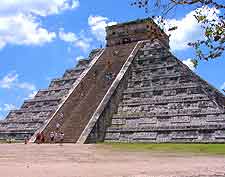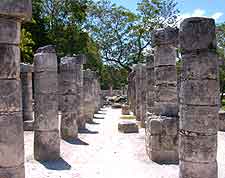Cancun History Facts and Timeline
(Cancun, Quintana Roo, Mexico)

In the 1960s, Cancun was a deserted island, consisting of several sand dunes shaped like a 'seven'. Before this time, few people even knew that it existed, with its recent history being fairly unremarkable.
The Mayans certainly left their mark, with a number of sites located in the city itself and just beyond its outskirts. Nowadays, Cancun is one of Mexico's best-known beach resorts, attracting all kinds of international tourists.
The Mayans
During the time of the pre-Colombian Maya civilisation, Cancun was known as Nizuc, a name believed to mean 'promontory'. At this stage in Cancun history, much of the population was wiped out by disease and conflict, with isolated communities left on
Cozumel Island and Isla Mujeres. El Rey, located in the Hotel Zone itself, is said to be one of the most accessible Mayan sites. However, serious Mayan history enthusiasts will want to travel farther afield to El Meco, a bigger mainland site in the direction of Punta Sam.
It is not known if the name Cancun has Mayan origins since it was first observed on 18th-century maps. Some historians believe that the Mayan translation is 'Throne of the Snake', corroborated by the snake icons that adorned many of the local sites. The city is also the gateway to other Mayan sites on the Yucatán peninsula, such as the wondrous Chichen Itza.

Early Developments
The development of Cancun was approved in 1969 and eventually began in 1970, with the construction of a road from Puerto Juarez and a small airfield. Interest from investors was slow, so much so that the Mexican government was forced to finance the first hotels.
Visitors who stay at 'Temptation Resort' will find themselves in the oldest hotel in Cancun, with this establishment dating back to 1974. The same year saw the inauguration of the resort's international airport, a key event in Cancun history, as well as the formation of the National Foundation for the Promotion of Tourism (FONATUR).
The Growth of Cancun
Cancun continued to grow during the 1980s, although the devastating 1988 Hurricane Gilbert served as a major setback. The city lost around US$87 million of tourist revenue in the wake of the hurricane, but soon bounced back and has shown resilience in the face of adversity ever since.
Since 1989, it has been regarded as the most dynamic city in Mexico, despite a further setback in 2001, when US terror attacks meant that many American citizens began to avoid overseas travel. The city continues to provide employment for many people from Yucatán and across Mexico, with its population now in excess of 500,000 people.
 In the 1960s, Cancun was a deserted island, consisting of several sand dunes shaped like a 'seven'. Before this time, few people even knew that it existed, with its recent history being fairly unremarkable.
In the 1960s, Cancun was a deserted island, consisting of several sand dunes shaped like a 'seven'. Before this time, few people even knew that it existed, with its recent history being fairly unremarkable.